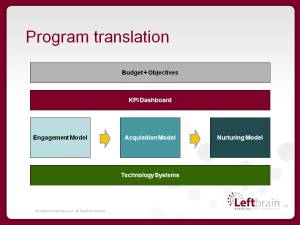This week I’m publishing a two-part blog series. This series takes a look at the challenge marketing leaders face in managing demand as an operational process. The first post presented an introduction to the topic and examined the issue of tracking B2B buyer behavior. The second post, today, looks at the fundamental issue of B2B marketing leaders’ ‘lack of an operations mindset.’ ~ABN
Problem Two: Our Lack of an Operations Mindset
Given we have a rapidly expanding set of technological capabilities – through marketing automation and similar platforms – to ‘track the buyer,’ what is remaining for us to effectively manage demand as an end-to-end, optimize-able process? I noted in the previous post in this series, “Clearly there is something else – something bigger – that is holding us back … .”
That bigger issue is B2B marketing leaders’ lack of an operations mindset.
This is the issue that B2B marketing leaders – especially CMOs – often can’t put their finger on, but that is at the core of much of our modern challenges. They talk about not being able to demonstrate the revenue impact of marketing; they talk about not having ‘hard numbers’; or they speak to not having a dashboard to really visualize marketing results. Obviously none of these ‘wants’ represent an operations mindset, per se, but they do represent the result of successfully managing demand as a process.
So how do B2B marketing leaders typically remedy this situation? They invest in technology, but when it comes to their marketing programs, they continue to do ‘more of the same.’
Therein lies the disconnect, as I note in Balancing the Demand Equation:
The disconnect: If as B2B marketers we are applying legacy mass-marketing, top-of-funnel techniques to the effort of customer acquisition and nurturing in an era of Buyer 2.0, there is a high likelihood that we will have a single, ineffective touchpoint with our buyer and then subsequently lose his/her engagement as (s)he goes through the buying process. Most of our demand generation programs thus remain highly inefficient, largely focused on awareness, and so we consistently lose track of warm leads that literally ‘leak’ out of our sale funnel, as Forrester has noted in its research. This is particularly problematic because Buyer 2.0 is moving forward in the buyer education process and will make a purchase, but if our B2B demand generation program loses touch with that buyer, the chance of him/her purchasing from us is greatly decreased.
Most B2B marketing organizations thus do not have a top-of-funnel problem. What they really have is a ‘middle-of-the-funnel’ problem.
This is why our B2B demand generation efforts cannot be haphazard or intermittent; instead, they need to be consistent and continuous processes. …
Yet it is exactly this type of a consistent and continuous B2B demand process – one that perpetually operates to move a buyer through multiple education and qualification stages (adjusting to the pace of the buying cycle), that combines both automated and live touch points and that only turns a lead over to sales after sufficient processing – that B2B marketing leaders are challenged to build.
We want a lead factory – a construct that requires understanding and enabling the multiple processing stages required to take in raw inputs and to churn out a finished product – but instead we deliver a series of ‘stage shows.’
What is at the core of this issue? It has nothing to do with good intentions; rather, it is the product of biases that are deep-rooted and fundamentally engrained in B2B marketers.
- First, right-brain/creative types are often drawn to marketing, not left-brainers.
- Second, marketing training at the vocational and academic level is focused on channels and tactics and on building consumer brands, but rarely speaks to the orchestration and coordination of multiple channels and tactics in a sequence to drive buyer dialogue.
- Third, on the off-chance a B2B marketer has some operations-analysis experience, it was probably garnered either in an MBA class or in an industrial setting, and it was probably applied to some sort of manufacturing process – meaning it never ‘clicked’ that this could also be applied to marketing.
- Fourth, the opportunities and challenges around such a complex, iterative and information empowered Buyer 2.0 are relatively recent; meaning, it truly is a changed world of marketing today from five years ago or ten years ago, when more ‘one-and-done’ tactics in more limited channels might have actually been a successful route.
It’s time for our training, bias and ultimate mindset as B2B marketers to catch up with our operational reality. So where do we need to focus our time and attention to drive change?






